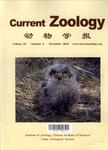Foraging ecology and occurrence of 7 sympatric babbler species (Timaliidae) in the lowland rainforest of Borneo and peninsular Malaysia
Foraging ecology and occurrence of 7 sympatric babbler species (Timaliidae) in the lowland rainforest of Borneo and peninsular Malaysia作者机构:The Evergreen State College Olympia Washington 98505 USA Grand Perfect Sdn. Bhd. ParkCity Commerce Square 97000 Bintulu Sarawak Malaysia Department of Forest Management Faculty of Forestry Universiti Putra Malaysia Serdang Selangor Malaysia Museum of Natural Science and Department of Biological Sciences Louisiana State University Baton Rouge Louisiana USA 70803
出 版 物:《Current Zoology》 (动物学报(英文版))
年 卷 期:2016年第62卷第4期
页 面:345-355页
核心收录:
学科分类:0710[理学-生物学] 07[理学] 09[农学]
基 金:Frank M. Chapman Memorial Fund of the American Museum of Natural History Charles M. Fugler Fellowship in Tropical Vertebrate Biology of the LSU Museum of Natural Science LSU Museum of Natural Science Tropical Bird Research Fund LSU Museum of Natural Science Research Award Disney Worldwide Conservation Fund Evergreen State College (ARS) Coypu Foundation of Louisiana Louisiana State University Sabah Softwoods Sdn. Bhd Grand Perfect Sdn. Bhd
主 题:Brunei dead leaves logged forest plantation Sabah Sarawak.
摘 要:Understanding foraging strategies of birds is essential to understanding mechanisms of their community assembly. To provide such information on a key Southeast Asian rainforest family, the babblers (Timaliidae), we evaluated foraging behavior and abundance in 7 morphologically and behaviorally similar sympatric species (Cyanoderma erythropterum, C. rufifrons, Stachyris maculata, S. nigricollis, S. poliocephala, Macronus ptilosus, and Mixornis gularis) in 5 habitats defined by structural complexity: (1) continuous native rainforest, (2) logged native rainforest fragments, (3) mature industrial tree plantation, (4) young industrial plantation, and (5) oil palm plantation. Enough data were obtained to compare abundance in all 7 species and foraging behavior in 5. All species were common in forest fragments and mature industrial tree plantations and less so in continuous rainforest and young industrial plantations; only M. gularis occurred in oil palm. In terms of foraging, M. gularis was the greatest generalist; C. rufifrons foraged mainly on live leaves in the forest midstory; and S. maculata, C. eryth- ropterum, and M. ptilosus foraged mainly on dead leaves suspended in understory vegetation at sig- nificantly different heights. The dead-leaf substrate depends on a rich supply of falling leaves and ex- tensive understory structure, conditions most common in native forest and old industrial plantations, and less so in mature forest, young plantations, and oil palm. Because of the importance of foraging data to understanding and managing biodiversity, we encourage the development of foraging fields in eBird (***), so that birdwatchers may help collect these relatively rare data.



